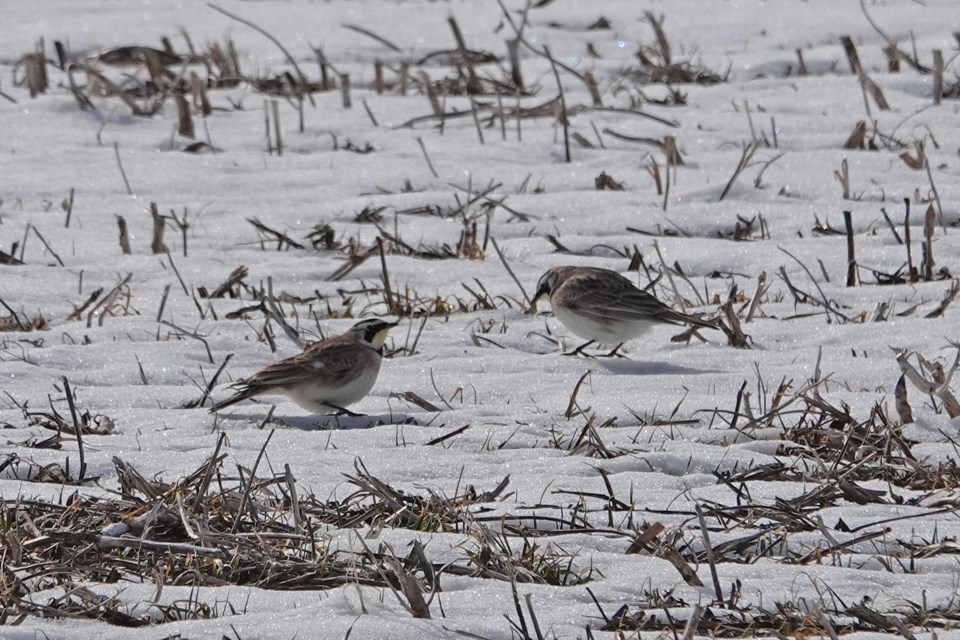We all have our personal signposts to mark the passing of each season, and spring usually has a plethora of them ... warm temps, melting snow, first flower, first robin, first blue-spotted salamander laying eggs in an ice covered vernal pool ... whatever makes you happy.
For me, the first real sign of spring is the return of the horned larks, as they often show up around here in mid-February in the midst of a snow storm. What could make one happier than to see a horned lark through an ice-encrusted windshield?
Like the great horned owl, the ‘horns’ are actually feather tufts that are obvious on each side of its head; ravens have them, too, but are really hard to see. Actually, all parts of the lark are hard to see, as they are very well camouflaged to blend in with the ploughed fields in which they often inhabit.
Being ground nesters, it is a real challenge for bird researchers to actually find an active nest, for as soon as the eggs hatch open the young are mobile (much like a killdeer). There are many observations of this species, but few confirmed breeding records.
However, in March the birds are at their most visible as they pair up and do courtship rituals on the shoulders of gravel roads. I had a wonderful opportunity to find and photograph a pair this week out near Elmvale; the road to Tiny Marsh has been a proven stomping grounds for these birds for decades.
And it’s always fun to learn something new about a familiar bird, in this case the field marks of a ‘prairie’ variety of horned lark versus the ‘northern’ variety. It’s all in the eyebrow colouration. Northern larks (which nest on the Hudson’s Bay shorelands) have a yellow eyebrow, while our local birds have a white eyebrow. I had to enlarge and review my photos to confirm that it was the ‘prairie’ version in the viewfinder.
The Ontario Breeding Bird Atlas has a great map of the breeding ranges of this species, and the colour coding clearly shows that this bird does not like the Canadian Shield country ... there is a well-defined edge along the northern border of the agricultural southlands (which they prefer) and the start of the pine and rock land portion of central Ontario.
Indeed, some avian historians question that the horned lark was even present in southern Ontario prior to colonization and the clearing of fields for agriculture; the main breeding area at that time would have been the shores of Hudson’s and James Bays. Or so they claim.
Other ‘historical’ stories paint a different story ... apparently the early voyagers and coureur de bois had a song they heartily sang while paddling their fur-laden canoes around the Great Lakes. And it went like this:
Alouette, gentille alouette.
Alouette, je te plumerai.
Je te plumerai la tete
Je te plumerai le bek.
Remember that one from elementary school? We learned to sing it in rounds with responding phrases back and forth. The big burly Frenchmen could be heard coming down the shore, their paddles swung to keep time to the music. Aww, they were so one with Nature… not!
Larks were often shot as a game bird and plucked for their meat. The song is all about plucking the feathers from a dead lark:
Lark, pretty little lark.
Lark, I will pluck you.
I will pluck your head.
I will pluck your beak.
And on it goes, ensuring glorious song is given to the plucking of its legs, wings, neck, eyes, beak and head. Admittedly, it was an easy way to learn the French names for body parts. Nowadays, rather than sing glorious to ripping birds apart, we tend to have other rhythmic songs to help us “dip, dip, and swing.”
But I digress. It is March and the horned larks are back! Another spring is upon us. Alouette, so nice to see you back again.



